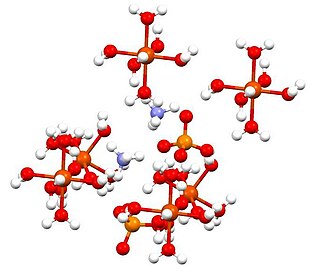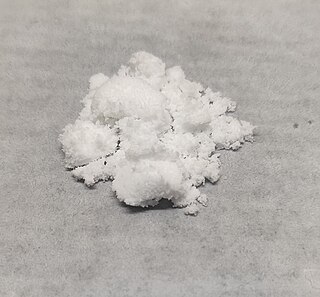
Lead(II) sulfate (PbSO4) is a white solid, which appears white in microcrystalline form. It is also known as fast white, milk white, sulfuric acid lead salt or anglesite.
In chemistry, water(s) of crystallization or water(s) of hydration are water molecules that are present inside crystals. Water is often incorporated in the formation of crystals from aqueous solutions. In some contexts, water of crystallization is the total mass of water in a substance at a given temperature and is mostly present in a definite (stoichiometric) ratio. Classically, "water of crystallization" refers to water that is found in the crystalline framework of a metal complex or a salt, which is not directly bonded to the metal cation.
Selenic acid is the inorganic compound with the formula H2SeO4. It is an oxoacid of selenium, and its structure is more accurately described as O2Se(OH)2. It is a colorless compound. Although it has few uses, one of its salts, sodium selenate is used in the production of glass and animal feeds.
Uranyl sulfate describes a family of inorganic compounds with the formula UO2SO4(H2O)n. These salts consist of sulfate, the uranyl ion, and water. They are lemon-yellow solids. Uranyl sulfates are intermediates in some extraction methods used for uranium ores. These compounds can also take the form of an anhydrous salt.

Silver sulfate is the inorganic compound with the formula Ag2SO4. It is a white solid with low solubility in water.

Vanadyl(IV) sulfate describes a collection of inorganic compounds of vanadium with the formula, VOSO4(H2O)x where 0 ≤ x ≤ 6. The pentahydrate is common. This hygroscopic blue solid is one of the most common sources of vanadium in the laboratory, reflecting its high stability. It features the vanadyl ion, VO2+, which has been called the "most stable diatomic ion".
Indium(III) sulfate (In2(SO4)3) is a sulfate salt of the metal indium. It is a sesquisulfate, meaning that the sulfate group occurs 11/2 times as much as the metal. It may be formed by the reaction of indium, its oxide, or its carbonate with sulfuric acid. An excess of strong acid is required, otherwise insoluble basic salts are formed. As a solid indium sulfate can be anhydrous, or take the form of a pentahydrate with five water molecules or a nonahydrate with nine molecules of water. Indium sulfate is used in the production of indium or indium containing substances. Indium sulfate also can be found in basic salts, acidic salts or double salts including indium alum.

Gold compounds are compounds by the element gold (Au). Although gold is the most noble of the noble metals, it still forms many diverse compounds. The oxidation state of gold in its compounds ranges from −1 to +5, but Au(I) and Au(III) dominate its chemistry. Au(I), referred to as the aurous ion, is the most common oxidation state with soft ligands such as thioethers, thiolates, and organophosphines. Au(I) compounds are typically linear. A good example is Au(CN)−2, which is the soluble form of gold encountered in mining. The binary gold halides, such as AuCl, form zigzag polymeric chains, again featuring linear coordination at Au. Most drugs based on gold are Au(I) derivatives.

Ammonium iron(II) sulfate, or Mohr's salt, is the inorganic compound with the formula (NH4)2Fe(SO4)2(H2O)6. Containing two different cations, Fe2+ and NH+4, it is classified as a double salt of ferrous sulfate and ammonium sulfate. It is a common laboratory reagent because it is readily crystallized, and crystals resist oxidation by air. Like the other ferrous sulfate salts, ferrous ammonium sulfate dissolves in water to give the aquo complex [Fe(H2O)6]2+, which has octahedral molecular geometry. Its mineral form is mohrite.
Vanadium(III) sulfate is the inorganic compound with the formula V2(SO4)3. It is a pale yellow solid that is stable to air, in contrast to most vanadium(III) compounds. It slowly dissolves in water to give the green aquo complex [V(H2O)6]3+.

Cobalt(II) sulfate is any of the inorganic compounds with the formula CoSO4(H2O)x. Usually cobalt sulfate refers to the hexa- or heptahydrates CoSO4.6H2O or CoSO4.7H2O, respectively. The heptahydrate is a red solid that is soluble in water and methanol. Since cobalt(II) has an odd number of electrons, its salts are paramagnetic.

Beryllium sulfate normally encountered as the tetrahydrate, [Be(H2O)4]SO4 is a white crystalline solid. It was first isolated in 1815 by Jons Jakob Berzelius. Beryllium sulfate may be prepared by treating an aqueous solution of many beryllium salts with sulfuric acid, followed by evaporation of the solution and crystallization. The hydrated product may be converted to anhydrous salt by heating at 400 °C.

Zirconium(IV) sulfate is the name for a family of inorganic salts with the formula Zr(SO4)2(H2O)n where n = 0, 4, 5, 7. These species are related by the degree of hydration. They are white or colourless solids that are soluble in water.

Chromium(II) sulfate is an inorganic compound with the chemical formula CrSO4. It often comes as hydrates CrSO4·nH2O. Several hydrated salts are known. The pentahydrate CrSO4·5H2O is a blue solid that dissolves readily in water. Solutions of chromium(II) are easily oxidized by air to Cr(III) species. Solutions of Cr(II) are used as specialized reducing agents of value in organic synthesis.
Gold(III) sulfide or auric sulfide is an inorganic compound with the formula Au2S3. Auric sulfide has been described as a black and amorphous solid. Only the amorphous phase has been produced, and the only evidence of existence is based on thermal analysis.
The sulfate fluorides are double salts that contain both sulfate and fluoride anions. They are in the class of mixed anion compounds. Some of these minerals are deposited in fumaroles.
The borosulfates are heteropoly anion compounds which have sulfate groups attached to boron atoms. Other possible terms are sulfatoborates or boron-sulfur oxides. The ratio of sulfate to borate reflects the degree of condensation. With [B(SO4)4]5- there is no condensation, each ion stands alone. In [B(SO4)3]3- the anions are linked into a chain, a chain of loops, or as [B2(SO4)6]6− in a cycle. Finally in [B(SO4)2]− the sulfate and borate tetrahedra are all linked into a two or three-dimensional network. These arrangements of oxygen around boron and sulfur can have forms resembling silicates. The first borosulfate to be discovered was K5[B(SO4)4] in 2012 by the research group of Henning Höppe, although the compound class as such had been postulated already in 1962 by G. Schott and H. U. Kibbel. Over 80 unique compounds are known as of 2024.

Nitratoauric acid, hydrogen tetranitratoaurate, or simply called gold(III) nitrate is a crystalline gold compound that forms the trihydrate, HAu(NO3)4·3H2O or more correctly H5O2Au(NO3)4·H2O. This compound is an intermediate in the process of extracting gold. In older literature it is also known as aurinitric acid.

Rhodium(III) sulfate refers to inorganic compounds of the formula Rh2(SO4)3. It is a red crystalline solid.

Transition metal sulfate complexes or sulfato complexes are coordination complexes with one or more sulfate ligands. Sulfate binds to metals through one, two, three, or all four oxygen atoms. Common are complexes where sulfate is unidentate or chelating bidentate. Examples are respectively [Co(tren)(NH3)(SO4)]+ (tren = tris(2-aminoethyl)amine) and Co(phen)2SO4. All four oxygen atoms of sulfate bond to metals in some Dawson-type polyoxometalates, e.g. [S2Mo18O62]4-.












